Radon in Air and Water
Radon in Water and Air
Health Risks and Control Measures
This document, a publication of the University of Maine, answers common questions about radon’s health effects and describes methods to reduce radon exposure.
- What is Radon?
- The chemical element radon is one stage in a natural radioactive decay chain.
- How Does Radon Get Into Homes?
- Radon enters homes primarily through soil gas and water.
- Where is Radon Found in Maine?
- Levels of background radiation due to the presence of radon are relatively high in most parts of Maine and the United States.
- How Does Radon Affect Health?
- The radioactive decay of radon produces fast-moving subatomic particles that can damage living cells.
- Health risks of airborne radon are estimated primarily on the basis of lung-cancer mortality rates of uranium miners who worked in poorly ventilated mines.
- What are the Projected Health Risks Associated with Radon?
- Radon is more likely to affect people through the air they breathe than through the water they drink.
- When Should I Take Remedial Measures?
- The “action level” is 4 pCi/L for radon in the air (USEPA) and 20,000 pCi/L for radon in water (State of Maine).
- How Do Risks from Radon Compare to Other Risks?
- Health risks from radon exposure can be put into perspective by looking at other causes of death and other sources of low-level radiation.
- Control Measures
- Methods are described for reducing radon levels in homes
- More Questions and Answers
- On health threats of radon, control measures, and testing of well water and air samples.
Radon is naturally occurring radioactive gas found in low concentrations almost everywhere on earth.
It is colorless, odorless, and chemically inert, like helium, neon, and the other so-called “noble” gases. It is fairly soluble in water.
Radon is the product of the radioactive decay of the element radium. Indeed, radon is midway in a chain of radioactive transformations originating with uranium (which has such a long “half-life” that one-half of the earth’s original compliment remains.)
THE NATURAL RADIOACTIVE DECAY CHAIN
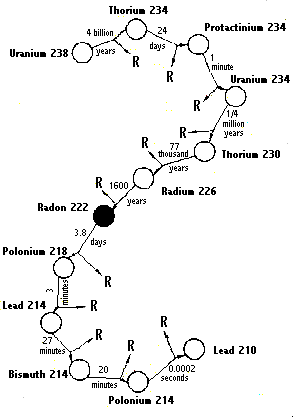
- R = radiation (alpha, beta, and gamma emissions)
- Half-life numbers are shown and indicate how long it takes for half of the atoms of each element to decay.
- Note that radon’s half-life is only 3.8 days.
When radon decays it emits from its nucleus an energized particle, called an “alpha particle”, and in the process is transformed into the next element. This element decays, also giving off radiation, and so on, until the series ends with a stable form of lead. The radioactive elements originating from radon are called “radon progeny”, three of which also give off alpha particles. Because it is a gas, radon is particularly mobile – able to move directly from the soil or indirectly, through well water, into our homes. And it is being continually replenished. Low-level radioactivity is measured in picocuries per liter (pCi/L), a term used throughout this document.
[ Top ]
HOW DOES RADON GET INTO HOMES?
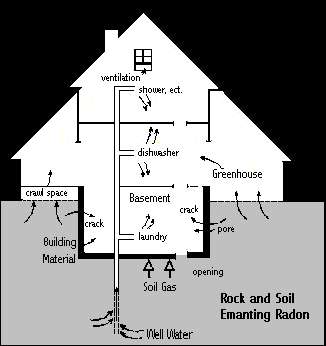
The sources of radon for any home might include:
- soil gas, infiltrating the air of the home;
- ground water, as it seeps through cracks in bed rock and soil – entering the house through well water; or
- construction materials.
Soil gas is the mixture of gases filling the tiny spaces between soil particles. Radon, being part of this mixture and a chemically inert gas, can diffuse through these spaces and into homes. Because of the upward flow of air in homes as heat is lost, the process can be amplified. Differences in air pressure can cause soil gas to be sucked into homes.
The importance of soil gas as a source of radiation is demonstrated by the fact that airborne radiation levels are often higher in basements than in other parts of the home. In 85 homes, University of Maine researchers found the following average airborne radiation levels:
- 6.4 pCi/L in Basements
- 3.4 pCi/L in Bathrooms
- 3.1 pCi/L in Kitchens/Living Rooms
- 3.0 pCi/L in Bedrooms
- 0.8 pCi/L in Outside Air
All ground water contains some radon, although levels vary greatly. As private wells tap ground water, dissolved radon escapes from the water and gets into household air in the course of dishwashing, showering, and other water-using activities. The radon may also enter our bodies through drinking water.
Most public water supplies have very low levels of radon, even if the water comes from municipal wells. This is primarily because such wells tend to tap sand and gravel groundwater aquifers with low levels of radon. Public water supplies also stand for a period before they are consumed and some decay of the radon takes place in that time.
Construction materials have not been found to be important source of radon in Maine. However, it is possible that concrete or brick made from materials with traces of radioactive materials may be significant sources of radiation in some cases.
[ Top ]
WHERE IS RADON FOUND IN MAINE?
Background radon levels vary considerably from one area to the next and from home to home. These variations mainly reflect differences in bedrock geology and soil conditions. The fact that radiation is usually present in soils, bed rock, and ground water has been known since the first decade of this century. However, only in the last 20 years or so has an awareness developed that radiation from natural sources may be high enough in some cases to represent health risks. In the 1960’s and early 1970’s it was discovered that radon levels in water from many wells in Maine were above drinking water standards that had been suggested at that time. Then, in the late 1970’s, researchers at the University of Maine found that
- radon levels were above 10,000 pCi/L in the water of many wells tested; and
- radon concentrations tended to be higher in areas having granite bedrock or pegmatites similar to granite.
The studies of the 1970’s have been supplemented by extensive tests of radon levels in both well water and household air- tests carried out by the state’s Department of Human Services, the Maine Medical Center Research Department, and University of Maine researchers. The following two maps show the results of these tests.
Map: Radiation levels in well-water vs. bedrock geology
Map: Average radon levels in household air and well-water, by county, in Maine
High radon levels are being found in many locations throughout the United States. For example, other areas in northern New England have radon levels similar to those found in Maine. A particularly active area has been found in southeastern Pennsylvania and adjacent areas in New Jersey (the ‘Reading Prong”). Indoor airborne radon levels as high as 300 to 400 pCi/L have been found in that area, and one home was found to have an extraordinary 2700 pCi/L in its air. The geological formations influencing radon levels in the Reading Prong area extend from Virginia to Connecticut.
Where ground water comes to the surface, it begins to lose radon to the air. This is why radon levels in lakes and rivers are low. Radon levels in the outside air are also very low as radon leaving the soil quickly mixes with the general atmosphere.
[ Top ]
What happens when radon and radon progeny are inhaled or ingested? Because radon is chemically inert, radon that is inhaled is also exhaled. Radon progeny, however, are chemically active, being metals, such as lead, bismuth, and polonium. These elements will stick to anything with which they come into contact such as particulates in the air, furniture and room surfaces. When inhaled, 30% of the radon progeny come in to contact with air passageways in the lung and adhere to the surfaces.
The health impacts of radon and radon progeny are due to the radioactive emissions of the various elements as they decay. Of the three kinds of emissions – alpha, beta, and gamma – alpha particles are the most dangerous. (An alpha particle is a helium nucleus moving at high speed.) Alpha particles are large. And while they do not penetrate far, alpha particles have very high energy and can do considerable damage to cells, such as those near the surfaces of respiratory passages.
Much of the radon ingested with water diffuses through the walls of the gut. Radon and its progeny can affect some cells in the stomach wall. However, because of the presence of food, much of the radiation is absorbed. Also, the exposure of the stomach and other organs in the digestive tract is limited. (The quantity of water consumed in a day is much less than the quantity of air that is breathed.)
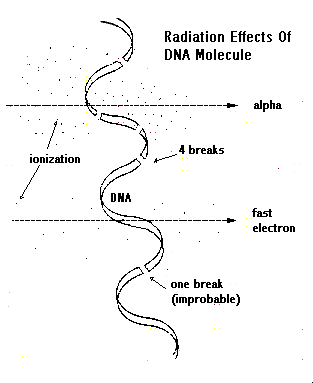
Health impacts are thus mainly due to alpha particle emissions from radon in air and radon progeny. As the particles pass through matter, they knock electrons off molecules, causing them to be broken and changed. Some of the changes can be harmful to living tissue. For example, if the information in a DNA (genetic) molecule is changed, the functioning of the whole cell can be altered, particularly when the cell reproduces itself.
Genetic molecules in tissue are frequently broken by random processes caused by normal body heat and various chemicals in the body. Enzymes in the body are usually successful in repairing single strand breaks in the DNA double helix. However, if there are multiple and simultaneous breaks – caused, for example, by an alpha particle – the DNA may very well be put back together wrong with possible ill effects on the cell it governs.
Estimating Health Risks of Radon
There is no direct and conclusive evidence linking radon exposure in the home to increased incidence of cancer. Estimates of health risks from radon exposure have to be made on the basis of studies of people who have been exposed to high levels of radiation. Such people include Japanese A-bomb survivors, workers who painted watch dials with paint containing radium, and uranium miners who worked in poorly ventilated mines. Data on the uranium miners has been found to be the most useful for estimating risks of “low-level” radon exposure in the home.
Where workers in uranium and other mines have been exposed over long periods to high concentrations of airborne radon, they have had significantly higher lung cancer rates. For example, a study of mortality rates of 4,000 U.S. uranium miners found there were 135 lung cancer deaths (up to 1974) in excess of the 16 that would have been predicted for the group with normal rates. The study (and graph below) shows that, at high doses, excess lung cancer mortality rates have been proportional to radiation exposure. The studies also found there was a delay of from 10 to 15 years between the time of exposure and the appearance of lung cancer caused by such exposure.
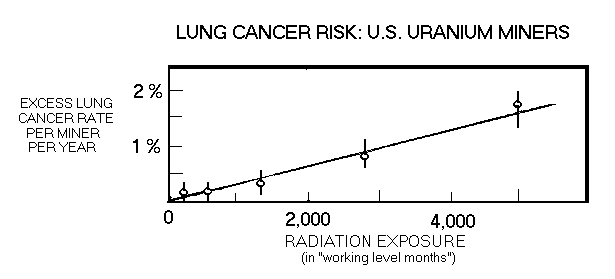
The projection of health risks from high radiation exposures to low exposures involves certain assumptions that reflect scientific opinion rather than facts. Is the health risk from low-dose radiation simply proportional to known risks of high-dose radiation? Or is there a threshold below which radiation represents no health risks at all?
For example, conclusions from the studies of uranium miners are fairly definite for radiation exposures over 500 rems (an exposure comparable to living for 60 years in a house with 10 pCi/L of radon in the air). There is evidence of excess lung cancer among miners down to the 40-50 rem exposure level, but knowledge of the health risks at these lower levels becomes increasingly ambiguous.
Scientists are left, then, with the necessity of making assumptions on how the known risks at high radiation levels should be projected down to low-dose levels. Majority opinion of scientists on a National Academy of Sciences committee favors a linear assumption for alpha-type radiation. The risk estimates given below are based on the linear assumption, but they should not be considered precise. The uncertainties are so great that the actual risks might double – or half – the estimated risks. Moreover, the health risks from radon may be multiplied when combined with exposure to other pollutants, such as those found in cigarette smoke. Such “synergistic” effects are not understood at this time.
[ Top ]
Scientists and people in public health agencies agree that health risks from direct consumption of well water are generally of minor significance. It is the air that residents of a house breathe that provides the greatest exposure to radioactivity. There is a constant exposure in breathing air in contrast to infrequent ingestion of drinking water. Periodic, short-term exposure to concentrated airborne radon due to such water-agitating activities as dishwashing, laundering and showering may double overall exposure.
The risk of dying from lung cancer as a result of airborne radon is estimated to be 1-2% for each 4 pCi/L of lifetime exposure. For drinking water, it is estimated that there is an additional lifetime risk of dying from cancer (primarily stomach cancer) of 1-2% per 20 to 40 thousand pCi/L in the water, depending on house size and ventilation.
These risk estimates should be viewed with some caution. They are based on assumed projections of high-level radiation risks to low-level risks. In the case of air radon, the ‘lifetime” exposure assumes 60 years and 100 years exposure in a closed house. In reality, of course, people spend time out-of-doors or away from their homes. Also, radon exposure is reduced when windows are opened in the summer or in bedrooms during sleeping hours.
Nevertheless, radon levels in some Maine homes clearly represent significant health risks. In a recent study, 13.5% of household air samples had airborne radon levels of 4 pCi/L or more. A few were in the 100 pCi/L range; one house had 500 pCi/L of airborne radon.
In the case of waterborne radon, l2% of 3,000 Maine homes tested had levels over 20,000 pCi/L. Levels over 100,000 pCi/L have been found in 30 to 40 homes in Maine, and several homes had levels over 1 million pCi/L in their water.
In the early 1990’s researchers at the University of Maine completed two studies on the contribution of domestic water use to indoor airborne radon exposure patterns. In the first of these studies, data from 68 homes was examined to determine the proportion of chronic airborne radon (and radon progeny) due solely to domestic water use. Comparison of radon levels to water usage show that water-derived airborne radon comprises, on average, about 32% of chronic domestic airborne radon levels. The balance comes mostly from radon in soil gas. In 14 of the 68 cases examined, radon from water use contributed more than 50% of the total airborne radon. 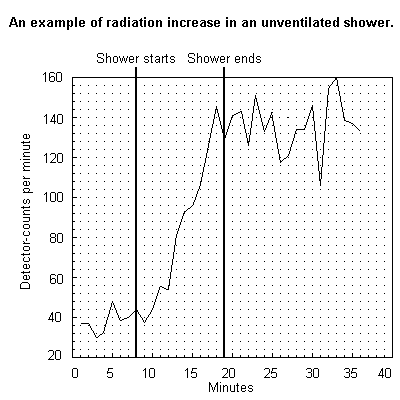
A second study examined acute exposure to radon. Acute exposure is short-term exposure to radon levels significantly above chronic levels, as may be experienced in a closed bathroom while showering. Monitoring radon levels in a closed bathroom (door closed, no vent fan) showed that within five minutes of initiating the shower, the level of radon in the bathroom began to climb rapidly. The radon level continued to climb until just after the shower was turned off, at which point the radon level stayed constant for approximately 15 to 20 minutes. About 75% of the radon in the water was released during the showering process. Increases in the amount of radon ranged from 2 to 114 pCi/L of air as a result of the shower. One house produced acute exposures that doubled the chronic exposure. Additionally, the study found that small, respirable aerosols of water (breathable water droplets) were generated that contained up to 80% of the radiation contained in all aerosols in the bathroom.
Two principal conclusions may be drawn from these studies, one optimistic and one pessimistic. The good news is that treating radon-laden domestic water may be an especially effective means to reduce total radon exposure in homes because removing radon from water is relatively easy, it virtually eliminates acute exposure and significantly reduces average indoor airborne radon levels. The bad news is that the repeated, acute exposure that may occur during normal use of untreated, radon-rich domestic water may be cause for increased estimates of health risk due to radon exposure.
[ Top ]
WHEN TO TAKE REMEDIAL MEASURES
The Maine Department of Human Services recommends that remedial actions be initiated where airborne radon levels exceed 4 pCi/L and water radon levels are above the 20,000 to 25,000 pCi/L range.
The significance of health risks from radon in the home is up to the individual to judge. Certainly radon exposures greatly above the action levels suggested would represent significant health risks. At the other end of the scale, some people could be more affected by worrying about radon than by the radon itself. In the great majority of cases, there is no immediate urgency. Decades of exposure might involve significant risks, but generally not a few months or even years of exposure.
[ Top ]
RISKS FROM RADON COMPARED TO OTHER HEALTH RISKS
Heart disease and cancer cause over half the deaths in the United States each year:
| Total deaths (1993) | 2,268,000 |
| from heart disease | 944,600 |
| from all cancers | 530,900 |
| (from lung and respiratory cancers | 156,600) |
| (from radon – U. S. EPA estimate | 14,000) |
| from all other causes | 792,500 |
As the table shows, more than 6 out of every 100 deaths are caused by lung cancer. In Maine, the number of annual lung cancer deaths is about 900. Smoking is responsible for 80 – 85% of lung cancer deaths. Other causes of lung cancer include many chemicals found in industrial settings and, to a lesser extent, in homes. Radon is thus only one of a number of indoor air pollutants.
Radon is second only to smoking, however, as a cause of respiratory cancer. Asbestos ranks third as a cause, followed by the other indoor pollutants. The U.S. Environmental Protection Agency (EPA) estimates that living with 10 pCi/L in the air is equivalent to smoking one pack of cigarettes a day. Another EPA estimate places the number of deaths attributable to radon each year at 14,000, within a range of 7,000 to 30,000 due to uncertianties discussed earlier.
People are exposed to many sources of radiation. However, as the chart shows, radon is the source of more than half of a typical individual’s radiation dosage from common causes.
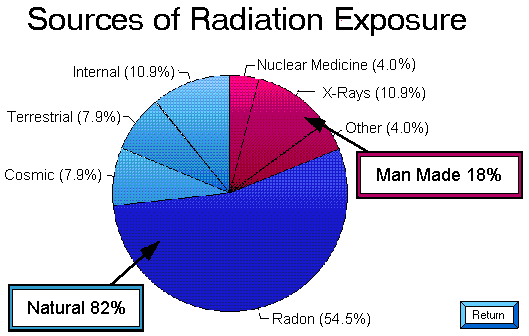
[ Top ]
As noted, the primary health risk is radon from the air. The key factors affecting airborne radon levels in the home are:
- radon levels in soil gas and type of construction where house and earth meet;
- radon levels in the well water and water-use habits; and
- ventilation rates of the house.
Soil gas can enter basements through dirt floors or cracks and other openings in the basement floor and foundation walls. Thus, the type of structure may be important, especially if the house is an old one. If a house or part of the house is built over a dirt-floor basement or unventilated crawl space, it may be exposed to excessive amounts of radon in soil gas. 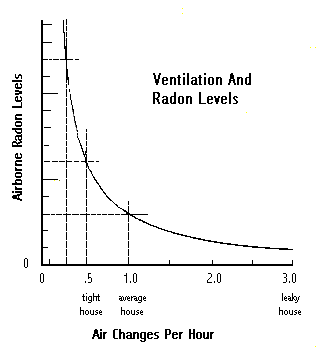
Radon in well water can be released into the air of the home in the course of various water-using activities. The rate at which radon is released from water to the air depends upon the degree to which the water is aerated. When water is agitated, the radon is released as much as eight times faster than when the water is standing and not agitated. Thus, the frequency of use of showers can affect airborne radon levels. Laundry and dishwashing machines can affect airborne radon levels too.
Differences in air radon levels from one house to another have little to do with differences in ventilation rates. However, within a given house, there is an inverse relationship between air-change rates and airborne radon levels. Thus, a reduction in ventilation rate from, say, one air change per hour to one-half air change per hour would double airborne radon levels.
Patterns of Radon Levels in Three Different Homes Monitored by University of Maine Researchers
The three graphs below illustrate patterns of airborne radon levels over two 24-hour periods in three homes monitored by University of Maine researchers. House A had a constantly high radon level – with fluctuations that corresponded to periods of water use. The house was tightly sealed and had an open drain in the basement (without a trap). Air in this drain had an extremely high radon level and appeared to be drawn into the house by the action of a wood furnace.

House B had the highest air-borne radon levels of any house tested up to that point. (Note the different scale on the left.) This house was a solar house with attached greenhouse, the foundation of which was sand and gravel over soil with granite bedrock not far below. Radon levels were so high in this house that fluctuations due to periods of water use could not be discerned.

House C exhibited the characteristics of a house where airborne radon came almost entirely from well water. The fluctuations corresponded entirely to times of water use, and radon levels diminished to near zero after the water use.

Where homeowners have radon levels exceeding the “action levels”, they have a lot of options. In deciding what actions to take, homeowners need to test their air and well water. They should then estimate:
- the most likely sources of radon;
- to what extent a particular control measure might reduce radon levels; and
- whether reduced health risks from such control measures justify their cost.
Homeowners may also need professional help in carrying out control measures
THE OPTIONS
Remove Radon from Well Water with Aeration System or Activated Carbon Filter.
- Aeration systems designed to remove radon from water in homes (preferred where radon levels are greater than 75,000 pCi/L) are available for about $2500.
- Water treatment units, using granular activated carbon (GAC) are available commercially. One can buy a unit that will remove 95 – 99% of the radon in water for approximately $900 – $1500.
- The GAC unit is similar to a water softener in which the softening compound has been replaced with granular activated carbon. A small sediment filter should be installed ahead of the GAC unit to minimize the need for backwashing.
Ventilate House
- Ventilation is a control method primarily for situations where airborne radon is due largely to water rather than soil gas. In any event, sealing the basement should precede increasing ventilation.
- Tightly scaled houses, such as those with solar and energy efficient designs, may have high levels of airborne radon from radiation sources that are relatively low (because of a low air-change rate).
- The ventilation rate of a tight house can be increased significantly by cracking a couple of windows during the winter (or installing an air-to-air heat exchanger).
- The cost of increased ventilation through cracking windows may be substantial. If a house were fairly well insulated and had one half air change per hour, adding another one-half air change would cut air-borne radon levels in half – but increase heating costs.
- The cost could be substantially reduced by ventilating certain rooms at certain times. Radon released in a closed bathroom during a shower can be largely prevented from entering the rest of the house by opening the bathroom window before opening the bathroom door – or through use of a ventilating fan.
- Heat losses can also be reduced significantly through use of an air-to-air heat exchanger. The units, which range from small window-mounted units to large floor-mounted units, can save up to 70% of the heat in the air exhausted to the outdoors.
- Increasing the air-change rate for a house – either by cracking some windows or using air-to-air heat exchanger – will reduce levels of all indoor air pollutants.
Seal and Ventilate Basement or Crawl Space
- Due to wind passing over a house and the pull of combustion air for heating or of ventilating air, the air pressure in a basement is usually higher than that in the soil surrounding the foundation. This pressure difference can cause large quantities of soil gas to be sucked through openings in the foundation.
- Major openings in foundations, such as drains or sump-pumps are easily recognized, but small cracks and openings in the basement floor and foundation walls can be difficult to detect.
- Untrapped basement drains have been found to be a significant source of radon in some regions. The cost of sealing or rerouting a drain, or installing a water trap (probably involving some tearing up of concrete and replacement of a few sections of pipe) will vary greatly from one house to the next.
- Epoxy paint or other polymeric coatings in multiple layers can be used to seal porous or cracked basement surfaces. However, rough areas in the surface should first be caulked and smoothed, so that there are no openings the paint cannot fill. The cost of sealing basement surfaces – by painting a basement with polyurethane, fur example – is quite low (under $100 for materials).
- A vent fan, used in conjunction with an air-to-air heat exchanger, can draw air into a basement from the outdoors to counteract air pressure differences.
- Air pressures can also be balanced by ventilating the area under the basement floor. This is done by a vent that draws air from under the basement floor and releases it to the outside.
- Adding ventilation to a tightly sealed crawl space (through vents) is not costly, although the resulting heat loss might be. Sheets of plastic can be put beneath floors to reduce radon diffusion (and the infiltration of cold air). However, to be effective, there must be no openings or cracks through which the radon can bypass the plastic.
[ Top ]
Q. Does radon cause nausea, dizziness or anything other than cancer?
A. No. There are no known health effects of radon other than cancer.
Q. How serious is the problem of radon and its health threats in Maine?
A. The U. S. Environmental Protection Agency estimates that, for the nation as a whole, approximately 14,000 lung cancer deaths a year are caused by radon, although the number could be as low as 7,000 or as high as 30,000. Cigarette smoking multiplies the risk of lung cancer due to radon exposure, especially troublesome for Maine with its higher-than-average rate of smoking.
Q. Are there other health threats – besides radon – due to natural radioactivity?
A. Yes. There may be other radioactivity in well water due to the presence of uranium or radium. It is measured by a “gross-alpha” test.
Q. Are there registered companies providing approved radon testing and mitigation services in Maine.
A. Yes. The Radon Registration Act (October1,1993) requires that people and companies providing radon testing, radon test analysis, and radon mitigation services in Maine meet minimum performance standards, keep up to date with new information and register with the Maine Bureau of Health, Radiation Control Program. Anyone legally performing radon testing or mitigation in Maine has an ID card that says they are registered to provide radon services. Contact the Maine Bureau of Health, Radiation Control Program by phone at 1-800-232-0842 and ask for radon information packet “T”.
Q. Where can I get more information on mitigation measures.
A. The pamphlet Radon Reduction Methods is available from the U.S. Environmental Protection Agency (JFK Federal Building, Boston, MA 02203).
Q. If I’m building a new house, is there anything I can do to minimize the chance of it having high radon?
A. Because of great variations from site to site, it is not worthwhile to have a sample of water tested from someone’s well near your lot. However, in constructing your house you could 1) build a very tight basement using poured concrete foundation walls; 2) ventilate the soil under the basement floor; and 3) use an air-to-air heat exchanger to provide adequate ventilation if you are building a tight, energy-efficient house.
On Radon Testing
Q. Should everyone have their houses tested for radon?
A. In Maine, yes. For people on public water, the Department of Human Services recommends testing of radon in air. For people with private wells, the Department recommends testing for radon in air and water (plus a test for “gross-alpha” in the water). The tests should be repeated after any mitigating measures have been taken to assure that acceptable results have been obtained – and annually, if radon-removal equipment has been installed.
Q. Where can I get testing done, and how much does it cost?
A. Maine citizens should contact the Health and Environmental Laboratory, Department of Human Services, State House Station 12, Augusta, Maine 04333 Tel. (207) 287-2727
Residents of other states should contact their respective radon coordinators, usually located in state departments of health.
The lab will send testing kits and full instructions on their use. Costs (Aug. 1996) are $22 for a test of an air sample, $25 for a test of radon in well water, and $35 for a test of “gross alpha” in the water.
Q. How many air samples should I have tested?
A. Initially one – in the kitchen. If the results are near or above the “action level” of 4 pCi/L, it would be advisable to have additional samples tested from the basement and, perhaps, a bathroom. The supplemental tests would help you determine whether radon in the air is coming primarily from soil gas or well water or both. And this information would help you choose among the control options described above. Note: household air should be tested only when the house can be closed for seven days (i.e., in any season but summer).
This document is an updated and expanded Web-version of an information digest, Radon in Water and Air (1983, Rev. 1986) prepared and distributed by the COOPERATIVE EXTENSION SERVICE, UNIVERSITY OF MAINE and THE LAND AND WATER RESOURCES CENTER (now THE WATER RESEARCH INSTITUTE), UNIVERSITY OF MAINE with the assistance of THE DIVISION OF HEALTH ENGINEERING, MAINE DEPARTMENT OF HUMAN SERVICES and the MAINE MEDICAL CENTER RESEARCH DEPARTMENT.
The 1983 publication was prepared by Sherman Hasbrouck with the graphics assistance of Carol Nichols. This web page was assembled by Robert P. Kilmer, kilmer31@maine.edu, a graduate student in Physics. Computer graphics files were prepared by Bernie S. Bernhardt and Robert P. Kilmer.
UM faculty members and others who have contributed to on-going studies of radon in Maine include:
- Charles T. Hess, Professor of Physics, hess@maine.edu
- Conrad Weiffenbach, former associate Professor of Physics
- Stephen A. Norton, Professor of Geology, norton@maine.edu
- Willem F. Brutsaert, Professor of Civil Engineering, willem@maine.edu
- Jerry D. Lowry, Associate Professor of Civil Engineering
- John C. Korsah, former Assistant Professor of Electrical Engineering
- Anne L. Hess, Clinical Psychology Associates
- George P. Bernhardt, Teaching Associate in Physics georgeb@maine.edu
The research on which this report is based was financed in part by the United States Department of the Interior, Geological Survey, through the Water Research Institute. Contents of this publication do not necessarily reflect the views and policies of the United States Department of the Interior, nor does mention of trade names or commercial products constitute their endorsement by the United States Government.
[ Top ]
